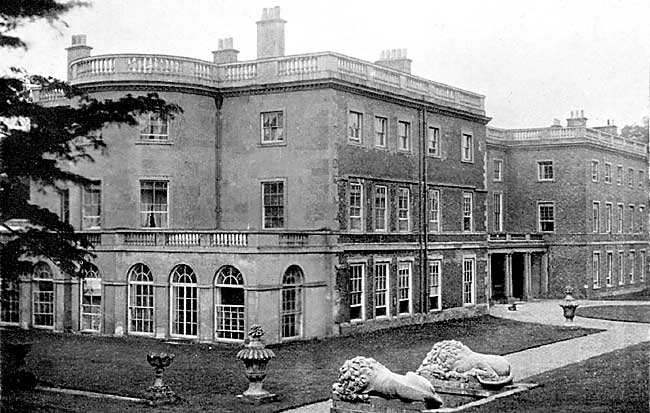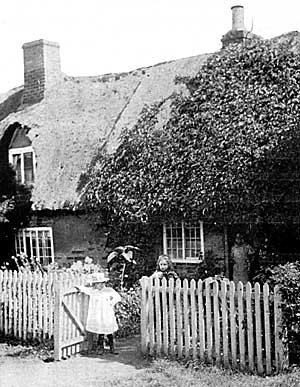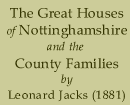< Chilwell | Contents | Clumber >
Clifton

Clifton Hall, c.1900.
OLD houses get into the possession of new families, who, by a convenient change of surname, obtain a fresh identity, and acquire in the County of their recent adoption, a position of territorial consequence. Very often it is an ordinary process of inheritance which brings new families into old houses ; sometimes it is success in trade. It is with some little astonishment, and perhaps a little envy, that we learn that Mr. So-and-So, in the midst of a successful business career, has taken such-and-such a hall, which for generations has been occupied by a county family, and identified with a county name—a house which has perhaps always taken a leading part in the affairs of the shire. It is with considerably less astonishment that we learn that an old estate has passed into the hands of a nephew or second cousin of the late owner, because that is a perfectly natural and regular change, and in the perpetuation of the family name, the anomaly, if there is one, is soon lost sight of. For centuries Clifton Hall has been occupied by a Clifton, and the family has been located in this county longer, perhaps, than any other that I could name. The Cliftons of Clifton have been men of title and consequence, their position and standing being derivable not alone from their landed possessions, but because of the part their family has played in the affairs of the nation, both civil and military.

Thatched cottage in Clifton, c.1910.
The surname of the Cliftons is derived from a village made up of a few thatched cottages, some of which have of late years acquired a tiled and conventional dignity, whilst others still retain their primitiveness, and the manor has been held by the family ever since Sir Gervase de Clifton purchased it of a certain De Rhodes, about the latter end of the reign of Henry the Third. This Sir Gervase was Sheriff of Nottingham as far back in forgotten centuries as 1279, and he was afterwards Sheriff of York, the lustre attaching to these honourable offices being somewhat dimmed by his committal to gaol for having made a false return of a writ. Both Sir Gervase de Clifton and Sir John de Clifton, who came afterwards, married into titled families, the former taking as his wife a daughter of Sir William Sampson, of Epperstone, and the hatter a daughter of Sir John Cressy, of Hodsock, both extinct county families. The last-named lady brought considerable property to the already large estates of the Chiftons. Her husband represented Nottingham in Parliament, and was one of the twelve gentlemen who received the spurs of knighthood on the morning of the Battle of Shrewsbury, where he was slain, together with Sir Nicholas Burden, of Maplebeck, Sir Hugh Shirely, of Radcliffe-on-Soar, and several other Nottinghamshire gentlemen. Then follows a long line of Cliftons, many of whom held important offices and rendered service to their country. There was Sir Gervase Clifton, of Clifton and Hodsock, who was Sheriff of Nottingham and Derby from 1471 to 1477, Receiver-General in those two counties, and Esquire to the body of Edward the Fourth. This gentleman played a prominent part in the disputes between the Yorkists and Lancastrians, and was engaged in the Battle of Tewkesbury. He was thought much of by the Lancastrian party, of whom the Duke of Somerset was the leader, on account of his firm devotion to their cause. This Sir Gervase married a lady of Kent, and was several times Sheriff of that County, and also Lieutenant of Dover Castle, under the Duke of Gloucester. For his faithful services Henry the Sixth conferred upon him the office of Treasurer of Calais and surrounding districts, and on the death of the then Archbishop of Canterbury the temporalities of that See were committed into his hands. He was also governor of several places in France. Ten years later the dispute between the two Houses of York and Lancaster is still rife, and we find the next head of the Cliftons, also a Sir Gervase, contrary to the principles of his family, allying himself with the Yorkists. This Sir Gervase was killed at Bosworth Field, the last of the thirteen contests between the Houses of York and Lancaster, which had extended over a period of more than forty years, filling the country with civil disturbance, and deluging its plains with blood. A circumstance is related in connection with the part Clifton took in the fray, which is at once interesting and affecting. He left his country seat in Nottinghamshire in company with Sir John Byron, a strenuous supporter of the Lancastrians, and they bound themselves by an oath that whichever of the two should survive the battle, should do his best to save the lands of the slain one from confiscation. Sir Gervase Clifton was mortally wounded, and Byron only arrived to hear his expiring words, "All is over; remember the oath between us!" Sir John Byron was no doubt true to his pledge. At any rate the history of Clifton contains no record of confiscation, and the house continued to furnish illustrious heads. A gentleman of considerable authority, both in peace and war, in four successive reigns, was the Sir Gervase Clifton, who is mentioned in a distich penned by Elizabeth,
"Gervase the gentle, Stanhope the stout,
Markham the lion, and Sutton the lout."
The other three names are those of Nottinghamshire gentlemen. The son of this distinguished soldier and courtier, who in times of peace was noted for the gentleness of his disposition, and the kindness of his heart, in turn left a son who died at the early age of twenty years, leaving behind him a son, Sir Gervase, who is said to have been even more gentle than his grandfather, and who has been described as "the most noted person of his time for courtesy." This Sir Gervase had a most conspicuous capacity for matrimony. He was married no fewer than seven times, and the names of these—most of them ladies of title—are recorded upon the canvas which hangs over the mantelpiece in the dining room at Clifton Hall, and upon which the strongly marked features of this remarkable personage appear. The first was the beautiful Penelope, daughter of Robert Earl of Warwick, and Penelope his wife. She was mother of the wretched, unfortunate Sir Gervase, his father’s greatest foil; she died October 26th, 1613, aged twenty-three years. The second was Frances, daughter of Francis Earl of Cumberland, and Grisilda, his countess. She brought him—1. Margaret, who was first married to Sir John South, secondly to — Whitchcote, Esq., and lastly to Sir Robert Carey; 2. Frances, first wife of Richard Temple, Esq., afterwards married to Anthony Eyre, Esq. 3. Anne, married to Sir Francis Rhodes; 4. Sir Clifford; and 5. Letice, wife of Clifton Rhodes. This second wife of Sir Gervase died November 22nd, 1627, aged thirty-three years. The third was Mary, daughter of Sir John Egioke, of Egioke, in Worcestershire, and Anne, his wife; she was widow of Sir Francis Leke, of Sutton, in the county of Derby, and died January 19th, 1630. The fourth wife was Isabel, daughter of — Meek, Esq., and relict of John Hodges, alderman of London; she died in July, 1637. The fifth was Anne, daughter of Sir Francis South, knight, of the county of Lincoln; she was buried at Clifton, June 1st, 1639. The sixth was Jane, daughter of Anthony Eyre, Esq., of Rampton, in the county of Nottingham ; she died in London, and was buried at Clifton, March 17th, 1655. The seventh and last wife was Alice, daughter of Henry, Earl of Huntington; she died after her husband, in the same year, 1666, at London, and was buried in St. Giles’ Church, as was also the third lady. But though matrimony went so largely to make up his celebrity, Sir Gervase did not allow his uxorious proclivities to interfere with the due discharge of important official duties, for he represented Nottinghamshire in Parliament in the reigns of James the First, Charles the First, and Charles the Second, and was Commissioner to the King during the Civil Wars. Thoroton says he most generously, hospitably, and charitably served all, from the King to the poorest beggar, that he was four score years Lord of Clifton, of a sound body, and a cheerful, facetious spirit. For his loyalty and fidelity, and for his general services to the State, James the First rewarded him with a baronetcy, one of the first of the order. He died in 1666, and was buried at Clifton. The succeeding generations of Cliftons were more or less mixed up with public life, and the representatives of this ancient family continued to occupy a leading position in the county. There was a Sir Gervase Clifton, who for some time represented East Retford in Parliament, and married a daughter of the Earl of Bellamont, and after him in 1767 the then Lord of Clifton was High Sheriff of Nottinghamshire. Little less than a century afterwards the last baronet was returned to Parliament by the electors of Nottingham, and enjoyed a popularity as remarkable as it was enduring. The late Sir Robert Clifton was three times elected Member of Parliament for Nottingham, and was an immense favourite with a large portion of the constituency. If the most ardent admirer of the late baronet was asked what were the special qualities which won this ever faithful support, he would probably be at a loss for an answer. The family name may have secured some of it; a certain open-heartedness and unfailing geniality on the part of the popular favourite, may have had something to do with his success, though these suggestions are, of course, of a distinctly speculative order. The fact remains that the late Sir Robert Clifton possessed the sublime secret of winning popular applause without any effort of his own. It came to him whether he would or no, and from his first connection with the borough in 1861, when he defeated the representative of a house almost as old as his own, and having a far greater stake in the county, down to the time of his death in 1869, he was the idol of a vast section of political Nottingham. But his charm died with him, and those who have sought to revive it have signally failed. In 1869 Cliftonism became extinct, and this venerable family died out. Upon the death of Sir Robert Clifton the baronetcy became dormant, and the estates of the Cliftons, together with their ancient house, passed to Mr. Henry Robert Markham, who is now lord of the manor, and was High Sheriff of this county in 1875. On coming to the estates Mr. Markham changed his name to Clifton, so that the family name, associated in times past with events which form part of the history of the country, is still perpetuated, and the river still flows beneath the home of the Cliftons, of Clifton.
